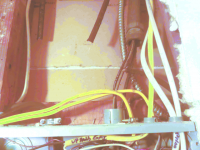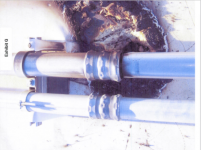You are using an out of date browser. It may not display this or other websites correctly.
You should upgrade or use an alternative browser.
You should upgrade or use an alternative browser.
Equipment Grounding Conductor History
- Thread starter anthonyklesta
- Start date
- Status
- Not open for further replies.
electrofelon
Senior Member
- Location
- Cherry Valley NY, Seattle, WA
- Occupation
- Electrician
That is refreshing to hear. I thought nearly everyone had succumbed to the cult of the green wire.In the past few years we've seen more and more projects where there are no wire type EGC's being used. MC-ap or EMT without an EGC is a great way to save money and developers are catching on to the fact that they've been wasting money on wire type EGC's for decades.
Here is part of the NFPA 99 wording, it concerns 517.13 (A) & (B)Commentary in a NFPA 99 annex points out that metallic conduit is the superior egc and the wire is basically a back up
Excerpt from NFPA 99 A6.3.3.1.3
Measurements have shown that it is the metal raceway and building steel that provide most of the effective grounding path of less than 10 milliohms at the receptacle, including plug-to-receptacle impedance. The green grounding wire becomes a backup, not a primary grounding path performer.
grich
Senior Member
- Location
- MP89.5, Mason City Subdivision
- Occupation
- Broadcast Engineer
Is there a link we can download and read with out joining or subscribing? perhaps on archive.org?

Determination of ground-fault current on common A-C grounded-neutral systems in standard steel or Aluminum conduit
A NEED has been indicated in the electrical industry for information which will enable the design engineer to predict the magnitude of fault current that will flow in a circuit enclosed by metal conduit when subjected to ground fault conditions. The purpose of this paper is to present usable...ieeexplore.ieee.org
The second one is more specifically on-topic, but not accessible without IEEE Library access.
1959 NM cable was available in either grounded or ungrounded. Sometime soon after that they started requiring the reduced grounding conductor in NM cable.
Conduit has always been optional to include a conductor inside metallic raceway or cable. I remember discussion in 1974 whether it was good practice, or wasteful.
I've seen thousands of conduits damaged defeating the integrity of conduit. People are rough on electrical equipment. One should never underestimate the destructive ingenuity of mankind.
Conduit has always been optional to include a conductor inside metallic raceway or cable. I remember discussion in 1974 whether it was good practice, or wasteful.
I've seen thousands of conduits damaged defeating the integrity of conduit. People are rough on electrical equipment. One should never underestimate the destructive ingenuity of mankind.
In a building with metal framing, metal plumbing, metal steam piping, metal ductwork, etc... a conduit could be pulled apart in numerous locations and still provide a low impedance fault clearing path, this is reflected in the NFPA 99 commentary.1959 NM cable was available in either grounded or ungrounded. Sometime soon after that they started requiring the reduced grounding conductor in NM cable.
Conduit has always been optional to include a conductor inside metallic raceway or cable. I remember discussion in 1974 whether it was good practice, or wasteful.
I've seen thousands of conduits damaged defeating the integrity of conduit. People are rough on electrical equipment. One should never underestimate the destructive ingenuity of mankind.
Yep, another case of human error. I wonder if they thought landing the wire EGC's was neccessary.Just found this gem of a install hiding in the wall above a panel this morning.
Panel looks to have been changed around 2009.
Conductors are old type r #8 solid.
View attachment 2566990
Knightryder12
Senior Member
- Location
- Clearwater, FL - USA
- Occupation
- Sr. Electrical Designer/Project Manager
I started in '84 and all I remember is pulling in an EGC. My thought process now as an electrical designer is that its a lot like Wi-fi, hardwired is better so I specify and EGC in everything because conduit can come apart, that wire cannot and if it does there is a bigger issue.I started offically in 1987 and back then we never pulled an EGC in a metal raceway. In my experience we didn't start pulling them until the mid to late 90s when IGs were becoming popular.
ggunn
PE (Electrical), NABCEP certified
- Location
- Austin, TX, USA
- Occupation
- Consulting Electrical Engineer - Photovoltaic Systems
I always have a ground wire, too.I started in '84 and all I remember is pulling in an EGC. My thought process now as an electrical designer is that its a lot like Wi-fi, hardwired is better so I specify and EGC in everything because conduit can come apart, that wire cannot and if it does there is a bigger issue.
See exhibits G and H.
Krusscher
Senior Member
- Location
- Washington State
- Occupation
- Electrician
When I started as an apprentice in 2010 I was taught not to run ground wires in conduit unless it was in an area it could easily be damaged, but we mostly ran rigid and pretty much all of it was connected to metal frames of machinery. Every time I have worked with a apprentice that came from somewhere else they tell me its against code not to run a wire type egc because that is what they were told
Frank DuVal
Senior Member
- Occupation
- Electrical Contractor, Electrical Engineer
Having worked in older buildings where either the initial install was poor (leaving locknuts and/or set screws loose) or buildings settling, I've seen scorch marks where the conduit was used as the EGC during faults. Even seen the rain of fire myself when resetting the breaker at the start of answering a "breaker blew" complaint. So I always run an EGC, I do not want to be the person blamed 30 years from now! 
Having worked in older buildings where either the initial install was poor (leaving locknuts and/or set screws loose) or buildings settling, I've seen scorch marks where the conduit was used as the EGC during faults. Even seen the rain of fire myself when resetting the breaker at the start of answering a "breaker blew" complaint. So I always run an EGC, I do not want to be the person blamed 30 years from now!
Your first step in troubleshooting a tripped breaker call is to reset it?

ggunn
PE (Electrical), NABCEP certified
- Location
- Austin, TX, USA
- Occupation
- Consulting Electrical Engineer - Photovoltaic Systems
And look for the flash, I assume.Your first step in troubleshooting a tripped breaker call is to reset it?
250.118 right? I just had an inspector say my two gang box, on a rigid offset needs a pigtail to it. This is for a 240V 14-40R.There are still a huge number of circuits being installed using the raceway as the equipment grounding conductor as permitted by the code.
Inspector says I can also use a grounding bushing which I thought was for line side over 250V
It happened the day after I was reviewing the Grounding and Bonding book p 222 - didn't get a response yet but I really don't need more wire in my box
Krusscher
Senior Member
- Location
- Washington State
- Occupation
- Electrician
I am guessing he is saying you need to bond your receptacle to your EGC ie your pig tail to box or a bond bushing. 250.148(B)250.118 right? I just had an inspector say my two gang box, on a rigid offset needs a pigtail to it. This is for a 240V 14-40R.
Inspector says I can also use a grounding bushing which I thought was for line side over 250V
It happened the day after I was reviewing the Grounding and Bonding book p 222 - didn't get a response yet but I really don't need more wire in my box
Krusscher
Senior Member
- Location
- Washington State
- Occupation
- Electrician
Looking into it more I guess I am wrong about that. As long as your receptacle has a self grounding tab on it then you don't need the bond between the box to the receptacle. 250.146 I always assumed they wanted it bonded if for some reason the raised cover was off the box it would no longer have a ground path.I am guessing he is saying you need to bond your receptacle to your EGC ie your pig tail to box or a bond bushing. 250.148(B)
Sberry
Senior Member
- Location
- Brethren, MI
- Occupation
- farmer electrician
In the box the tab is legal, if the device is mounted in the cover then you need a pigtail to the box.
- Status
- Not open for further replies.



